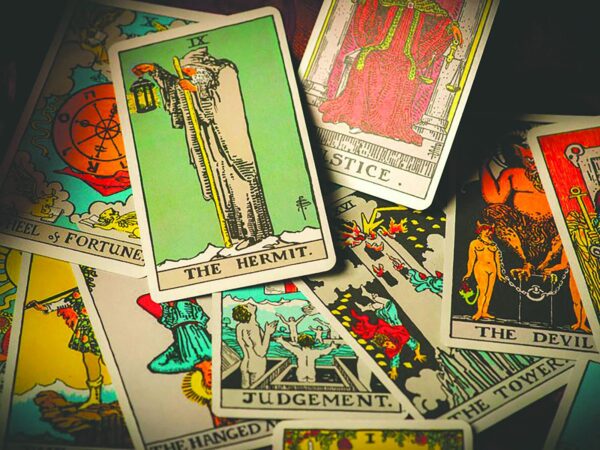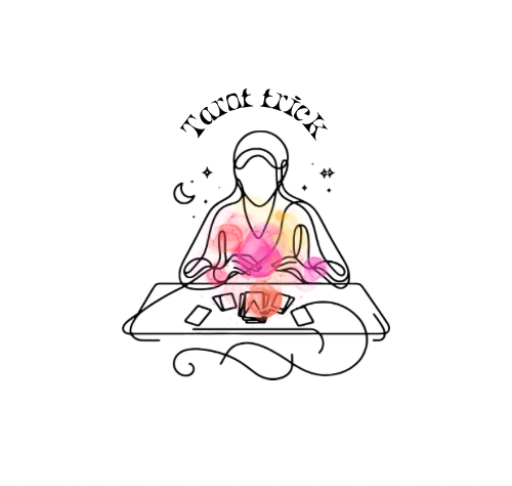
Tarot cards are a deck of 78 cards used for divination, self-reflection, and spiritual guidance. The Tarot deck is typically divided into two sections: the Major Arcana and the Minor Arcana.
- The Major Arcana – 22 cards representing key life lessons, spiritual growth, and transformative events. These cards delve into the bigger themes of existence, such as The Fool, The Magician, The High Priestess, and The World.
- The Minor Arcana – 56 cards that focus on day-to-day life and experiences. These cards are divided into four suits: Cups, Pentacles, Swords, and Wands, each of which corresponds to different aspects of life like emotions, wealth, intellect, and creativity.
Tarot Card Meanings and Symbols
Each Tarot card comes with its own unique symbolism and meaning, often rooted in archetypes, astrology, numerology, and mythology. Tarot card meanings can vary depending on the deck you use, but each card has a general set of interpretations.
- The Fool is often associated with new beginnings, spontaneity, and the start of a journey.
- The Empress represents nurturing, abundance, and fertility.
- The Tower signifies sudden upheaval, unexpected change, or revelation.
Tarot cards are rich with symbolism that speaks to the unconscious mind, providing insights into your current situation, challenges, and potential future outcomes.
How To Tarot Cards Work?
Tarot cards are often used as a tool for divination, but their function goes far beyond predicting the future. Many people use Tarot as a way to tap into their intuition, explore their subconscious, and gain deeper insights into their lives.
Here’s how Tarot card readings typically work:
- Shuffling the Deck: The person receiving the reading (known as the querent) will shuffle the deck while thinking about their question or situation. This process helps to focus their energy and intentions.
- Card Spread: After shuffling, cards are drawn and laid out in a particular pattern, known as a “spread.” There are many different Tarot spreads, from simple 3-card spreads to complex Celtic Cross spreads. The cards’ positions in the spread indicate different aspects of the querent’s question or situation.
- Interpreting the Cards: Once the cards are laid out, the Tarot reader interprets them based on their positions and their individual meanings. Some readers also consider the card’s position relative to the question being asked and the surrounding cards.
Can Tarot Cards Predict the Future?
While Tarot cards are often associated with fortune-telling, their primary purpose is not to predict the future in a definitive way. Instead, Tarot provides guidance, offering insights into potential outcomes based on the current path.
The future is not set in stone—Tarot offers a glimpse into the energies at play in your life and helps you understand how different choices might unfold. In essence, Tarot helps you to see where you might be heading, allowing you to make more informed decisions.
How to Start Using Tarot Cards for Yourself
If you’re new to Tarot and interested in starting your own practice, here are some tips to help you get started:
- Choose a Tarot Deck: There are hundreds of different Tarot decks out there, each with its own artwork and interpretation of the Tarot symbols. Choose a deck that resonates with you. Some popular beginner decks include the Rider-Waite Tarot, the Thoth Tarot, and the Wild Unknown Tarot.
- Learn the Meanings of the Cards: Take the time to study the meanings of the Major and Minor Arcana. There are many resources available online, as well as books and courses designed to teach you how to interpret the cards.
- Start with Simple Spreads: When you’re starting out, stick to simple Tarot spreads, such as a 1-card pull for daily guidance or a 3-card spread to explore past, present, and future influences on a situation.
- Trust Your Intuition: While learning the meanings of the cards is important, Tarot reading is as much about intuition as it is about memorizing definitions. Over time, you’ll develop your own personal connection with the cards, and your intuition will help guide your interpretations.
- Keep a Tarot Journal: As you begin to practice, it’s helpful to keep a Tarot journal where you record your readings, thoughts, and any personal insights you receive. This will help you track your progress and notice patterns in your readings.
Benefits of Using Tarot Cards
- Self-Reflection and Personal Growth: Tarot cards can be a powerful tool for self-exploration. Whether you’re facing a tough decision or simply seeking clarity, the cards can help you connect with your higher self and gain new perspectives on your life.
- Decision-Making: Tarot can help illuminate your options, providing guidance when you’re faced with difficult choices. While the cards won’t tell you exactly what to do, they can help you see potential outcomes and the energies influencing your situation.
- Spiritual Guidance: For many, Tarot is a tool for connecting with their spiritual guides, intuition, and higher wisdom. The cards can offer messages from the spiritual realm or insights into your soul’s journey.
- Creative Inspiration: Tarot cards can also serve as a muse for artists, writers, and other creative individuals. The rich symbolism and imagery of the cards can spark new ideas and help you explore new creative projects.
Final Thoughts
Tarot cards are much more than just a mystical tool for fortune-telling. They offer a rich, symbolic language that can help you gain clarity, enhance self-awareness, and tap into your intuition. Whether you’re using them for personal guidance, self-discovery, or spiritual growth, Tarot cards can serve as a powerful tool in your life.
If you’re interested in learning more about Tarot, exploring different Tarot spreads, or receiving a personalized reading, there are plenty of resources available to guide you on your journey. Start with an open mind and a willingness to explore the wisdom the cards have to offer!
